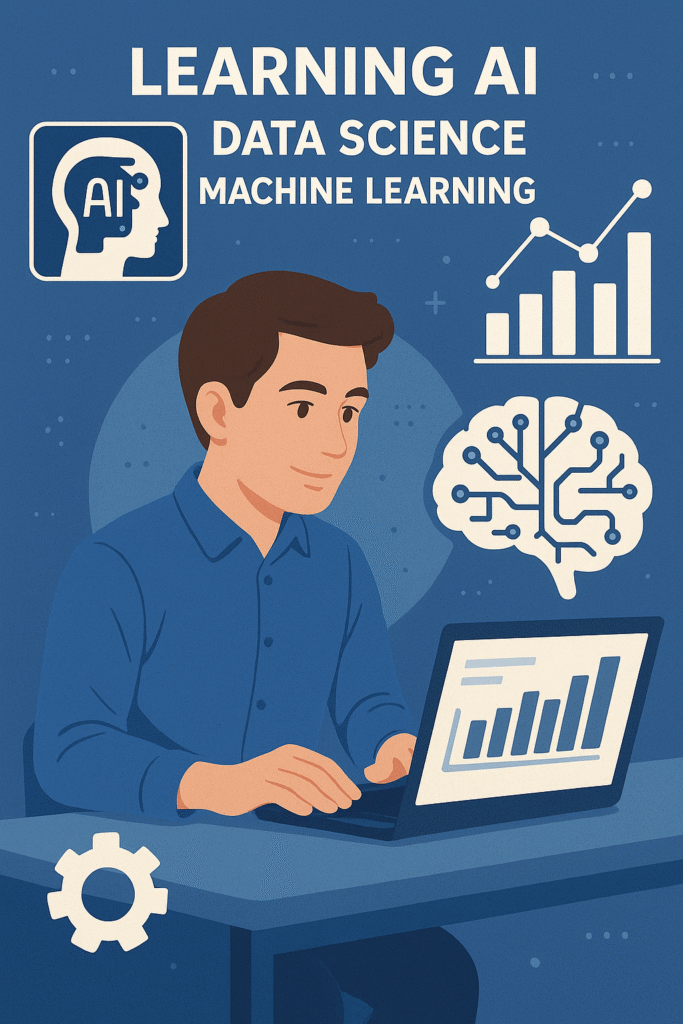Your Step-by-Step Guide from Python Basics to Deep Learning Mastery

So You Want to Learn AI? Here’s Everything You Need to Know
What Is AI—and Why Should You Care?
Artificial Intelligence (AI) enables machines to simulate human intelligence—learning, reasoning, adapting, and improving.
AI is now embedded in everyday tools and services—from personalized recommendations to autonomous vehicles and medical diagnostics.
Learning AI empowers you to build the future, solve meaningful problems, and stay ahead in a rapidly evolving job market.
Why Learn AI in 2025?
AI skills are no longer optional. They’re essential for modern professionals, entrepreneurs, and creatives.
- High demand across industries like finance, healthcare, and tech
- Lucrative salaries for AI professionals and data scientists
- Limitless innovation opportunities for creators and developers
- Strategic advantage in a world increasingly driven by automation
How to Learn AI from Scratch: A Beginner’s Roadmap
You can start your AI journey right from home with a laptop, internet connection, and a structured plan.
1. Learn Python – Your First AI Language
Python is the most widely used programming language in AI development. It’s readable, beginner-friendly, and has rich libraries for machine learning and data science.
Recommended resources:
- Python.org
- FreeCodeCamp Python tutorials
- Coursera – Python for Everybody
2. Strengthen Your Math Foundation
Understanding the math behind AI models helps you make better decisions and troubleshoot your models.
Focus on:
- Linear Algebra
- Probability and Statistics
- Calculus (mainly derivatives and gradients)
Learn from:
- Khan Academy
- 3Blue1Brown’s YouTube series
3. Explore the Fundamentals of Machine Learning
Machine Learning (ML) is the core of AI. It’s the process of training machines to identify patterns and make predictions from data.
Start with:
- Supervised vs. unsupervised learning
- Regression, classification, and clustering
- Neural networks
Courses to try:
- Andrew Ng’s ML Course – Coursera
- Google ML Crash Course
4. Build Practical Projects
Hands-on practice is crucial. Apply what you’ve learned through real-world mini-projects.
Project ideas:
- Predict house prices based on location and size
- Create a movie recommendation system
- Develop a basic chatbot
- Detect spam emails
Tools to explore:
- Kaggle
- Google Colab
- Hugging Face
5. Join the AI Learning Community
Stay inspired, get feedback, and find opportunities by connecting with other learners and professionals.
Where to engage:
- Reddit (e.g., r/learnmachinelearning)
- LinkedIn groups focused on AI
- Discord communities
- GitHub repositories and open-source projects
What Comes Next? Dive Deeper
Once you’ve grasped the basics, consider exploring specialized domains:
- Deep Learning – CNNs, RNNs, GANs
- Natural Language Processing (NLP) – Chatbots, summarizers, translators
- Computer Vision – Object detection, facial recognition
- Reinforcement Learning – Agents learning through interaction
Tips for Long-Term Success
- Be consistent. Set weekly learning goals.
- Learn by doing. Projects reinforce theory.
- Document your journey. Blogs, notebooks, and code reviews help retention.
- Ask for help. Use forums and mentors when you’re stuck.
- Stay curious. New tools and breakthroughs appear every month—keep exploring.
Final Thoughts: AI Is for Everyone
AI is no longer exclusive to academics or tech giants. It’s open to anyone with the drive to learn.
Whether you want to enhance your career, build a startup, or simply understand the tools shaping our future—AI is your next big step.
The best time to learn AI was yesterday. The second-best time is today.
Leave a Reply